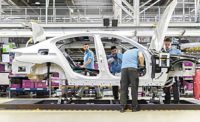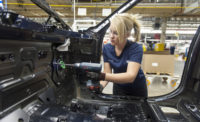VALENCIA, Spain—Autonomous vehicles from Ford are still a few years away, but one little robot is already showing what’s possible.
Nicknamed “Survival,” because of its ability to adapt to its environment, the self‑driving robot delivers spare parts around Ford’s assembly plant here, dodging unforeseen objects, changing its route if obstructed and stopping whenever necessary.
Developed entirely by Ford engineers, it is the first of its kind to be used in any of the company’s European facilities.
“We programmed it to learn the whole of the plant floor so, together with sensors, it doesn’t need any external guides to navigate,” says Eduardo García Magraner, engineering manager at the plant. “When it first started, you could see employees thinking they were in some kind of sci-fi movie, stopping and staring as it went by. Now they just get on with their jobs knowing the robot is smart enough to work around them.”
Delivering spare parts and welding material to different stations around the plant is a crucial element in keeping production going. For Ford workers though, the task is time-consuming and relatively mundane. The robot does not replace employees, but can save up to 40-employee hours every day by taking over this role, allowing operators to use their time on more complex tasks.
The robot is equipped with an automated shelf that has 17 slots to hold materials of different weights and sizes. To avoid errors, the opening and closing of these slots is automated, meaning operators in each area only have access to the materials assigned to them.
The self-driving robot uses LiDAR (Light Detection and Ranging) technology to visualize its surroundings, a technology also used in Ford’s prototype autonomous vehicles.



